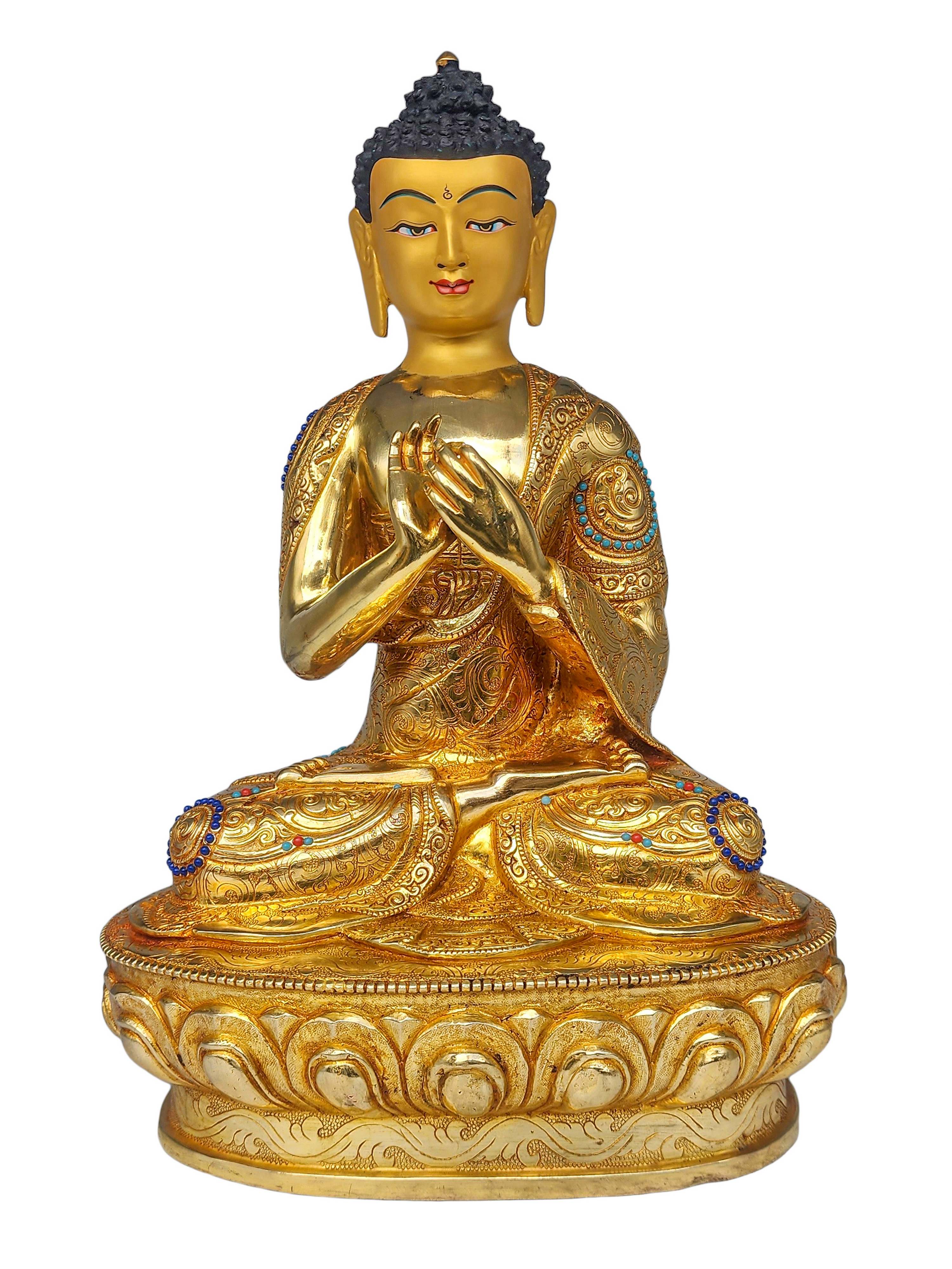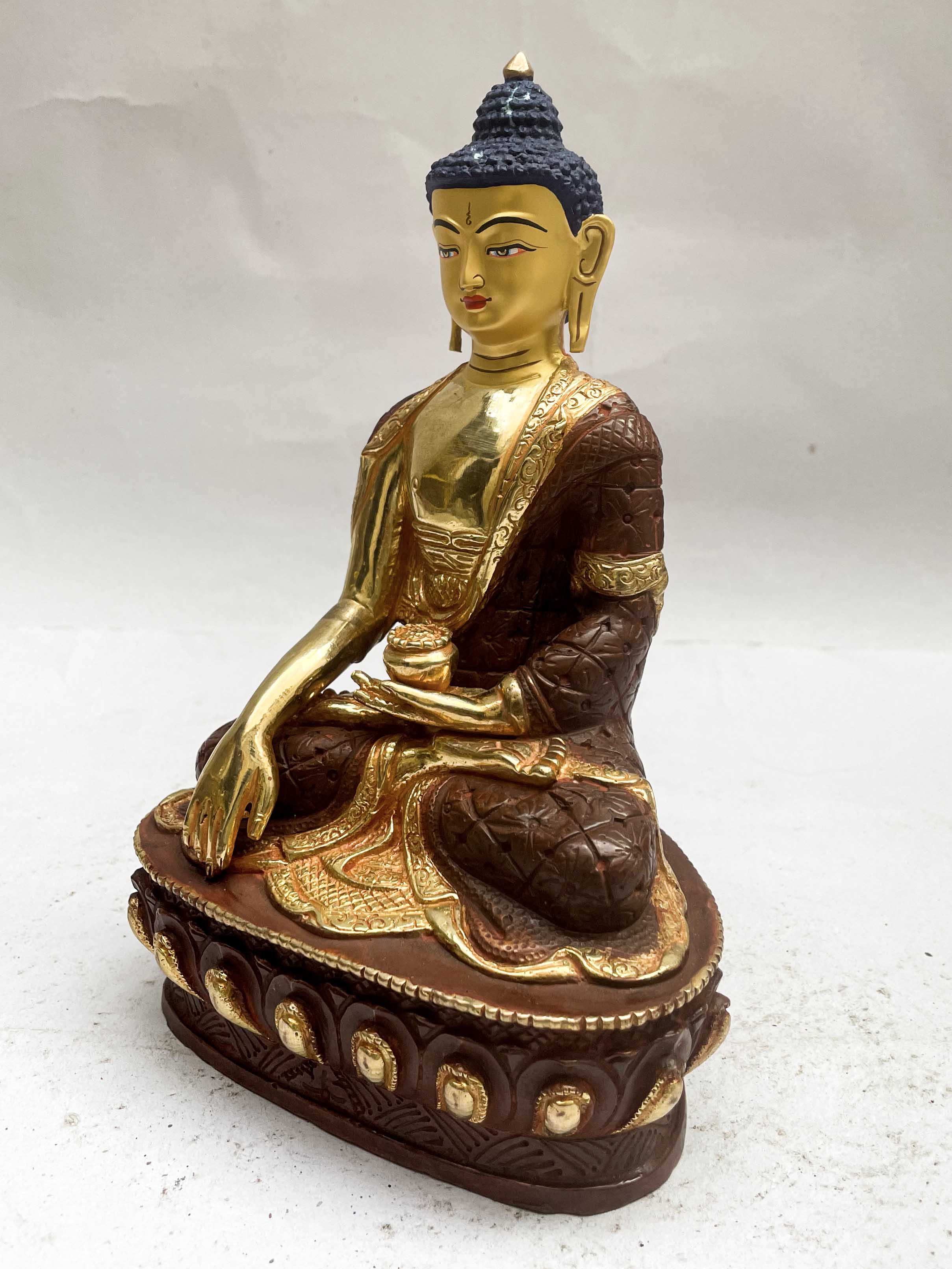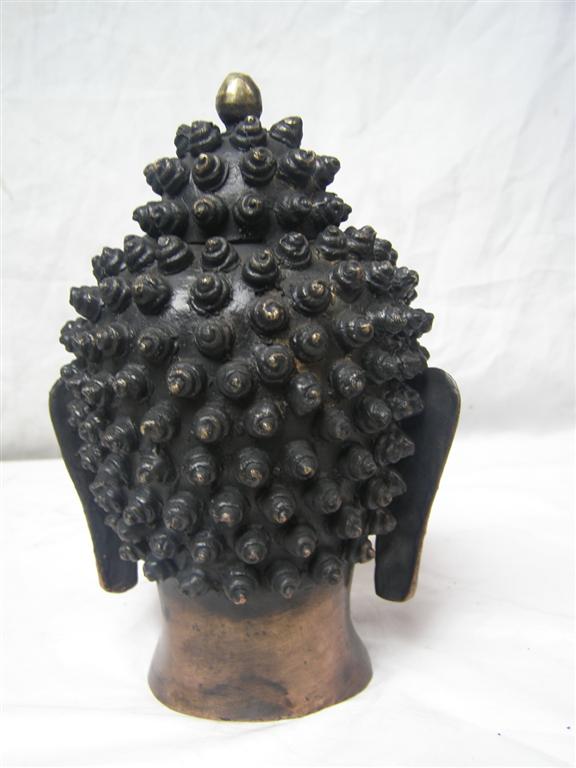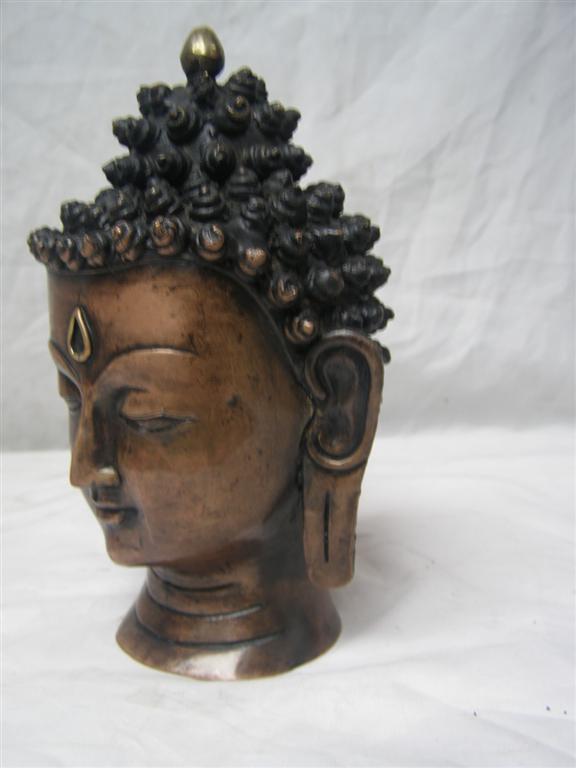Code
HCS31342
Weight
3.136 Kg / 6.91 lbs
Size
Height
32cm (13") Width
21cm (8") Depth
14cm (6") Material
Copper
Availability
Available

Safe Payment
We accept Paypal, Money Transfer, Bank Transfer
Confidence
Protection covers your purchase and personal data.
Worldwide Delivery
We ship Worldwide, except Russia.Shipping cost US$25.2 for upto 0.5 kgs

Hotline
Talk to help line for your question on 9841267335Finishing: Stone Setting
The [amoghasiddhi Buddha], Buddhist Handmade Statue, [face Painted], [gold Plated] And [stone Setting] is adorned with an exquisite array of semi-precious stones, including turquoise, coral, and lapis lazuli. These stones are carefully selected and meticulously placed on the [amoghasiddhi Buddha], Buddhist Handmade Statue, [face Painted], [gold Plated] And [stone Setting]'s surface, adding a touch of opulence and enhancing its overall beauty. Each stone is thoughtfully positioned using a high-quality adhesive, ensuring secure and long-lasting attachment. The vibrant colors and unique patterns of the stones create a captivating contrast against the backdrop of the [amoghasiddhi Buddha], Buddhist Handmade Statue, [face Painted], [gold Plated] And [stone Setting], elevating its visual appeal and making it truly eye-catching. Read More . . .
The [amoghasiddhi Buddha], Buddhist Handmade Statue, [face Painted], [gold Plated] And [stone Setting] is adorned with an exquisite array of semi-precious stones, including turquoise, coral, and lapis lazuli. These stones are carefully selected and meticulously placed on the [amoghasiddhi Buddha], Buddhist Handmade Statue, [face Painted], [gold Plated] And [stone Setting]'s surface, adding a touch of opulence and enhancing its overall beauty. Each stone is thoughtfully positioned using a high-quality adhesive, ensuring secure and long-lasting attachment. The vibrant colors and unique patterns of the stones create a captivating contrast against the backdrop of the [amoghasiddhi Buddha], Buddhist Handmade Statue, [face Painted], [gold Plated] And [stone Setting], elevating its visual appeal and making it truly eye-catching. Read More . . .
Gold Painted Face
The face of [amoghasiddhi Buddha], Buddhist Handmade Statue, [face Painted], [gold Plated] And [stone Setting] is painted with gold to enhance its significant features, particularly the eyes, and lips. This detailed painting is essential as it brings forth the crucial attributes of the expression of eyes and lips that metal carving alone cannot capture.
Moreover, the painted face serves as a symbolic and sacred ritual in Buddhism, preparing the statue for consecration and practice. The act of painting the face with gold in Buddhism holds deep meaning. It represents the intention to bring life and expression to the statue, imbuing it with a sense of vitality and presence. The application of gold on the face showcases the devotion and craftsmanship of the artisans, ensuring that every detail is carefully attended to honor the sacred essence of the [amoghasiddhi Buddha], Buddhist Handmade Statue, [face Painted], [gold Plated] And [stone Setting]. Read More . . .
The face of [amoghasiddhi Buddha], Buddhist Handmade Statue, [face Painted], [gold Plated] And [stone Setting] is painted with gold to enhance its significant features, particularly the eyes, and lips. This detailed painting is essential as it brings forth the crucial attributes of the expression of eyes and lips that metal carving alone cannot capture.
Moreover, the painted face serves as a symbolic and sacred ritual in Buddhism, preparing the statue for consecration and practice. The act of painting the face with gold in Buddhism holds deep meaning. It represents the intention to bring life and expression to the statue, imbuing it with a sense of vitality and presence. The application of gold on the face showcases the devotion and craftsmanship of the artisans, ensuring that every detail is carefully attended to honor the sacred essence of the [amoghasiddhi Buddha], Buddhist Handmade Statue, [face Painted], [gold Plated] And [stone Setting]. Read More . . .
Full Fire Gold Plating
This [amoghasiddhi Buddha], Buddhist Handmade Statue, [face Painted], [gold Plated] And [stone Setting] is finished with full gold plating. also known as mercury gold plating or fire gold plating. This traditional technique involves the application of a genuine layer of gold onto the [amoghasiddhi Buddha], Buddhist Handmade Statue, [face Painted], [gold Plated] And [stone Setting]. Referred to as mercury gold plating, it is considered the correct and authentic form of gold plating in Nepal. Despite being more expensive than electroplating, this traditional mercury gold plating is gaining popularity again in Nepal. People are drawn to its authenticity, longevity, and the unmatched beauty it brings to the [amoghasiddhi Buddha], Buddhist Handmade Statue, [face Painted], [gold Plated] And [stone Setting]. The resurgence of interest in this traditional form of gold plating reflects a growing appreciation for the craftsmanship and cultural heritage of Nepal Read More . . .
This [amoghasiddhi Buddha], Buddhist Handmade Statue, [face Painted], [gold Plated] And [stone Setting] is finished with full gold plating. also known as mercury gold plating or fire gold plating. This traditional technique involves the application of a genuine layer of gold onto the [amoghasiddhi Buddha], Buddhist Handmade Statue, [face Painted], [gold Plated] And [stone Setting]. Referred to as mercury gold plating, it is considered the correct and authentic form of gold plating in Nepal. Despite being more expensive than electroplating, this traditional mercury gold plating is gaining popularity again in Nepal. People are drawn to its authenticity, longevity, and the unmatched beauty it brings to the [amoghasiddhi Buddha], Buddhist Handmade Statue, [face Painted], [gold Plated] And [stone Setting]. The resurgence of interest in this traditional form of gold plating reflects a growing appreciation for the craftsmanship and cultural heritage of Nepal Read More . . .
Lost-Wax System
This Buddha of [amoghasiddhi Buddha], Buddhist Handmade Statue, [face Painted], [gold Plated] And [stone Setting] is made by the process of the Lost Wax system. This is a very complicated, time consuming and historic process of making metal sculptures.Which is why it is sometimes called Precision Casting as well. Hence the sculptures made by this process are comparatively expensive. There are many new, advanced and less time consuming methods of casting metal sculptures available as well. But due to the benefits provided by the traditional lost wax system in quality control and customization, we prefer the Loss wax system over Ceramic molding, or sand casting to make our Buddha.
Below we have tried to illustrate the process of making a loss wax system statue: Read More . . .
This Buddha of [amoghasiddhi Buddha], Buddhist Handmade Statue, [face Painted], [gold Plated] And [stone Setting] is made by the process of the Lost Wax system. This is a very complicated, time consuming and historic process of making metal sculptures.Which is why it is sometimes called Precision Casting as well. Hence the sculptures made by this process are comparatively expensive. There are many new, advanced and less time consuming methods of casting metal sculptures available as well. But due to the benefits provided by the traditional lost wax system in quality control and customization, we prefer the Loss wax system over Ceramic molding, or sand casting to make our Buddha.
Below we have tried to illustrate the process of making a loss wax system statue: Read More . . .
Brief Introduction :
Amoghasiddhis is one of the five important Dhyani Buddhas. His name describes his characteristics perfectly. Amogha(Amoha) means the exclusion of confusion or spiritual ignorance, siddhi means Mastery in a subject. So in Amoghashiddhi is a Master to help remove confusion and spiritual ignorance.
"Mogha" can also be translated as a failure, unfruitful, or unsuccessful. Thus Amoghasiddhi is also the master of success, the one whose success cannot be obstructed. This is perhaps the most common description for Amoghasiddhi, "the Buddha of unobstructed success."
Teachings of Amoghashiddi :"Mogha" can also be translated as a failure, unfruitful, or unsuccessful. Thus Amoghasiddhi is also the master of success, the one whose success cannot be obstructed. This is perhaps the most common description for Amoghasiddhi, "the Buddha of unobstructed success."
Amoghasiddhi teaches us that Spiritual understanding is the deepest and fullest grasp of the universal truth that every experience and every object arises out of certain conditions. Likewise, every object and every experience becomes part of the conditions out of which other objects and experiences in turn arise.
A dynamic, endlessly unfolding. That is Amoghasiddhi's field, his home. So the wisdom of dwelling in this place is the wisdom of actions that are perfected. Actions are performed for the good of all beings, and the actions accomplish that perfectly. This world of perfected action is one of perfected conditions: harmonious, serene, pure.
Icongraphy of Amogshiddhi :A dynamic, endlessly unfolding. That is Amoghasiddhi's field, his home. So the wisdom of dwelling in this place is the wisdom of actions that are perfected. Actions are performed for the good of all beings, and the actions accomplish that perfectly. This world of perfected action is one of perfected conditions: harmonious, serene, pure.
Amoghasddhi's direction is the north. His time is midnight and so in visualizing Amoghasiddhi he is surrounded by a sky of midnight blue. His element is air, and thus he has the power of the wind, both fierce and gentle, warming and cooling, a baby's breath, a tree-breaker. His particular wisdom, as we have discovered, is the wisdom of all accomplishing action. He is described as the Buddha of the realization of the Bodhisattva path, a Buddha of actions, actions perfected and free of karmic consequences, actions that are pure, crystallized and transparent.
Amoghasiddhi's color is green. His vehicle is Garudha a half human and half bird, mythical imaginary creature. Amoghasiddhi's sits in abhaya mudra with his right hand held palm facing outward in front of the heart, this Mudras mean protection and removal of fear. That quality of fearlessness essential to living the spiritual life. His spiritual object is the double dorje that symbolizes the highest comprehension of truth, the incomparable power of a Buddha.
Amoghasiddhi's color is green. His vehicle is Garudha a half human and half bird, mythical imaginary creature. Amoghasiddhi's sits in abhaya mudra with his right hand held palm facing outward in front of the heart, this Mudras mean protection and removal of fear. That quality of fearlessness essential to living the spiritual life. His spiritual object is the double dorje that symbolizes the highest comprehension of truth, the incomparable power of a Buddha.
Mantra of Amoghsiddhi
OM AMOGHASIDDHI AH HUM


![[amoghasiddhi Buddha], Buddhist Handmade Statue, [face Painted], [gold Plated] And [stone Setting]](https://handicraftseller.com/uploads/pics/product/thumb/2023/12/31342.jpg)
![[amoghasiddhi Buddha], Buddhist Handmade Statue, [face Painted], [gold Plated] And [stone Setting]](https://handicraftseller.com/uploads/pics/product/thumb/2023/12/31342_0.jpg)
![[amoghasiddhi Buddha], Buddhist Handmade Statue, [face Painted], [gold Plated] And [stone Setting]](https://handicraftseller.com/uploads/pics/product/thumb/2023/12/31342_1.jpg)
![[amoghasiddhi Buddha], Buddhist Handmade Statue, [face Painted], [gold Plated] And [stone Setting]](https://handicraftseller.com/uploads/pics/product/thumb/2023/12/31342_2.jpg)


























































 Master Quality, Buddhist Statue
Master Quality, Buddhist Statue  Master Quality, Buddhist Statue
Master Quality, Buddhist Statue  Shakyamuni Buddha, Buddhist Handmade Statue,
Shakyamuni Buddha, Buddhist Handmade Statue,  Shakyamuni Buddha, Buddhist Handmade Statue,
Shakyamuni Buddha, Buddhist Handmade Statue,  Chocolate Oxidized,
Chocolate Oxidized,  Chocolate Oxidized,
Chocolate Oxidized,  Vairochana Buddha, Buddhist Handmade Statue,
Vairochana Buddha, Buddhist Handmade Statue,  Vairochana Buddha, Buddhist Handmade Statue,
Vairochana Buddha, Buddhist Handmade Statue,  of Shakyamuni Buddha,
of Shakyamuni Buddha,  of Shakyamuni Buddha,
of Shakyamuni Buddha,  of Shakyamuni Buddha,
of Shakyamuni Buddha,  of Shakyamuni Buddha,
of Shakyamuni Buddha, 

 Glossy,
Glossy,  Glossy,
Glossy,  of Amitabha Buddha,
of Amitabha Buddha,  of Amitabha Buddha,
of Amitabha Buddha,  Shakyamuni Buddha, Buddhist Handmade Statue,
Shakyamuni Buddha, Buddhist Handmade Statue,  Shakyamuni Buddha, Buddhist Handmade Statue,
Shakyamuni Buddha, Buddhist Handmade Statue,